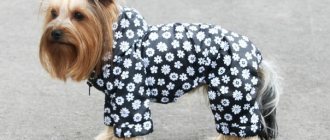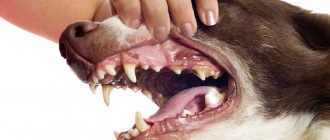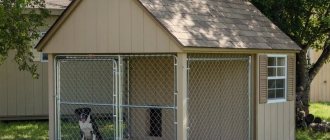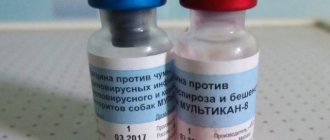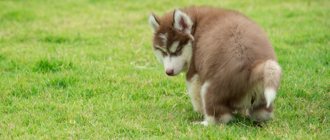Some dog breeds require additional protection and clothing. The point is not only that they need to stay warm when walking in winter or other cold seasons. Sometimes it is important to have protection if they have recently had surgery. This applies mostly to pets with short hair. The most suitable option for dogs of all breeds and sizes is a blanket. It can prevent dirt from getting into wounds, keep you warm in winter and at the same time allow your pet to move freely without restricting its movement. The idea of creating this type of clothing initially appeared among horse breeders, but migrated and took root among dogs and cats. This article will describe in detail how to make a blanket for a dog with your own hands, patterns for similar products, how to take measurements from a dog and much more.
How to take measurements from a dog
Sewing clothes for dogs and other animals is similar to the process of sewing for humans. It is also necessary to take measurements, since clothes that are too narrow or wide will hinder movement or, conversely, drag on the ground.
You can make a bandage for a dog yourself
To take measurements of a dog, it must be placed on a horizontal and straight surface so that it stands stable and straight, with all four paws touching it. To do this, the dog is calmed down. You can even feed her in the process. In the process of taking measurements, it is necessary that the centimeter does not lie too closely to the body, but does not sag. This means that when wrapping, the tape should move calmly in different directions.
Sequence of taking measurements
The main measurements for sewing and knitting are:
- Back length.
- Neck circumference.
- Chest circumference.
- Waist circumference.
- Distance from front to rear paws.
- Distance between front paws.
- The length of the front and rear legs (from the armpits to the surface on which the dog is standing).
- Distance from the armpits of the front paws to the genitals (only for males).
You may be interested in: Simple patterns of travel pillows for your car yourself
DIY clothes for cocker spaniel
Sewing techniques and subtleties
Many people mistakenly assume that it is much easier to sew clothes for a Chihuahua or Yorkie than for large breed dogs. In fact, rather the opposite. The pattern pieces are so small that much more time is wasted.
For your pet’s comfort, you should pay attention to the seams: they should be soft, without tangled threads or extra pieces of fabric. Clothes for dogs should not restrict movement or be tight. The collar and leash are worn under clothing, so you should take care of the holes for them. The genitals of males and females should be open, and attention should also be paid to this.
How to sew a blanket for a dog with your own hands: step-by-step instructions
When all materials and tools are prepared, you can start sewing. To do this, the pattern details are transferred to the fabric: main and lining. Don't forget to leave a 1 centimeter allowance at the edges.
Important! Each pattern piece is half a piece. That is why, when a person begins to transfer the pattern onto the fabric, it is necessary to fold it in half and apply the part to the fold with the corresponding line.
A jumpsuit or blanket after surgery is very important for maintaining health.
When all the parts are cut, they need to be unfolded. The lining can be made in such a way that it completely copies the base, or it can be done a little differently. Naturally, the top of the dog’s body receives most of the precipitation in winter or autumn, so the back should be lined with membrane or waterproof fabric. After this, the two parts are sewn together, and the unstitched holes are left for turning the product inside out.
It is best to sew the back parts along the neck, and the lower and side parts to the notches that will meet at the neck. The belly is stitched almost completely, turned inside out and stitched. All that remains is to stitch the lining so that it does not stick out, and turn out all the parts that are sewn together to complete the process. For fixation, it is best to use sewn-in elastic bands or Velcro.
Postoperative blanket diagram
Dog blanket - my sewing experience
One day (after another unscheduled wash) I wanted to equip my dog with some protective clothing in case of wet/dirty weather. But I don’t want to buy expensive overalls for a growing puppy in pet stores or second-hand, and I don’t want to order from China - “however, the dog could grow up during the journey.”
Coincidentally, at the same time I got a sewing machine. The last time I sewed on a machine was quite a long time ago, during labor lessons at school, and even then, at the last bell, the teacher came up to me and asked me to finish it and bring “that unfinished skirt.” In general, zero experience, maximum enthusiasm, the dog is in shock - we need to start sewing.
As Google told me, first you need to make a pattern. The same Google cruelly lied to me that for the pattern it is enough to measure only the length of the dog’s back from the collar to the tail. I can now say that this is not enough if your dog is not spherical in a vacuum - the collar did not fit mine (too big, which is why the whole blanket slid back very far and began to interfere with the tail), between the front legs was also too big. These dimensions still need to be adjusted to your pet so that the finished product does not hang like a bag and interfere with movement.
So, the pattern. The size of one cage is the distance from the collar to the tail divided by ten.
The diagram shows a part folded in half along the fold line. Accordingly, you need twice as much fabric + allowance for allowances. For the lining, I bought a regular raincoat fabric (black), for the front side - a red raincoat fabric glued to fleece, so it turned out to be some kind of insulation.
I made patterns on the wallpaper left over after the renovation; I applied allowances to the fabric itself, departing from the original outline by about a centimeter.
After I cut out both patterns from the lining and facing fabrics, my crookedness showed up - the details of the lining and facing fabric did not match:
Since I didn’t want to redo it, and also because I’m my mother’s engineer, I found a way out of this situation: I made a fold in the center of the black fabric, which compensated for the extra width, and simply secured it with machine stitching. Since this is a lining, it’s not a big deal; the front one would still have to be cut out again.
The next step is stitching the parts together. If you know how to sew on a machine, it’s easy and simple, for me the whole process was torture, especially the rounding.
The photo shows where there is no thread - these places do not need to be sewn at this stage:
So far, all this creativity looks like an armor breastplate and a cover for a whale’s tail. It becomes simply a matter of principle to turn this couple into something meaningful.
We turn the parts inside out through the holes left and sew them with a front seam - this will make the contours clearer and will not allow the lining to move out. The dotted lines on the back part mark the places that also need to be stitched, folding them with their front parts facing each other - you get a half-sewn collar:
The model was tired even before connecting the parts and decided to sleep with the idea that now they would put it
.
Meanwhile, for a long time I could not understand how to connect these parts with each other. As a result, I inserted the unsewn part of the belly part into the unsewn part of the collar, secured it manually with large stitches and sewed it on a machine:
Here I discovered that the collar had come apart a little at the top, well, that’s okay, I’m sewing for the first time, besides, I can sew it on the wrong side and pretend that’s how it’s supposed to be done.
All that remains is to sew on an elastic band so that the blanket does not dangle in the lower part of the belly, and Velcro to somehow secure it all to the dog:
Result on the model:
It is unknown when I will get around to repeating this experience and taking into account all the mistakes, but for now I will hope that by the dirty spring season the dog will grow up and the blanket will be just right.
How to sew elbow pads for a dog
These parts serve as protection for the paws of dogs who prefer to constantly lie on hard surfaces. First of all, these are home clothes and you need to take them off before going outside. They prevent the appearance of calluses, and if they already exist, then no infection will get into the wounds.
It is best to order flexible and stretchy accessories made of synthetic material, but you can make them yourself. To do this, you should use children's tights or sweaters that have good elasticity. It all depends on the size of the dog. Calluses are typically found in larger breeds.
Dog elbow pads
Tips for sewing clothes for dogs of different breeds
Good quality clothing directly depends on the correctness of the measurements taken and the making of the pattern. Even a novice seamstress can transfer the finished pattern onto fabric. You should pay attention to the accessories: tapes, zippers, fasteners, Velcro, elastic bands. They are found in almost every model of dog clothing.
Note! Dogs do not like clothing that is tight and restricts movement. Pants should not drag on the asphalt; the cuffs must be secured with elastic bands or laces.
Clothes for large breed dogs
Pattern of a cap for a dog
First you need to take the necessary measurements: the length from the eyes to the base of the head along the top of the head. To this value add 2.5 centimeters for the bend of the fabric. The second measurement is similar, but measured between the ears. 5 millimeters of allowance are also added on each side. The last measurement is the circumference of the head with the forehead and chin. This parameter is divided by 4 and multiplied by 3. Also, an increase of 2.5 centimeters is added on each side for seams and bends of the material.
You might be interested in: Features of paint for denim products
Pattern of a cap for a dog of any size
Important! Next, we begin making the pattern. It is shown in the picture below. It is applied on paper with a millimeter square. The visor and its length are made at will. After the drawing is ready, it is cut out and the pattern is ready.
Measurements for a dog vest
Stylish overalls with a hood for Chihuahuas
As always, first you need to make a pattern on paper. Check all measurements and cut out parts. Attach the pattern with pins to the fabric and trace each detail with chalk, making an indent of 1 cm.
Manually sew the parts together and try them on. In this case, you need to pay attention so that the product does not fit very tightly, but is not too large. If necessary, adjust the future overalls. After fitting, sew all the details using a machine.
Important! It is necessary to process the edges so that they do not come apart
At the last stage, you need to sew fasteners to the product and decorate it with decorative elements.
Vest for a dog - pattern
For the vest you will also need to take several measurements:
- Chest circumference at its widest point.
- Neck circumference at the base.
- Length of the back from the base of the tail to the withers. Measured only in a quiet stance.
The last value is needed to determine the side of the square of the drawing. The length of the back is divided by 10. This will be the size of the square for the pattern. After measurements, it is necessary to accurately transfer all the details onto the grid.
The vest replaces pants and a T-shirt
For production you will need:
- Lining stitch. Usually this is fabric on padding polyester.
- Membrane material that “breathes” and has water-repellent properties.
- Zipper or special Velcro. It is best to use the first option.
You can take the pattern on the Internet or build it yourself if you have the appropriate experience. After this, all the details of the drawing are transferred to the fabric. Do not forget about allowances of 1 centimeter.
Important! If the drawing from the Internet says “fold line,” then the part must be applied to a piece of fabric folded in half. In this case, the conditional line should lie at the very place of the fold.
You need to sew the vest along the side marks
The lower part should be cut with a fold, and the back should consist of two parts. The lining is cut so that it completely copies the details of the membrane fabric. After cutting, the lining and base parts are sewn on the sides from the inside out. The lining and membrane are connected with the front parts and stitched along the bottom of the vest and along the sections for the sleeves.
All this is turned right side out and darned with a finishing stitch along the bottom of the product and the edges. The shoulder sections are swept away, and the resulting design is applied to the dog. Now is the time to determine whether the vest is suitable and change it.
You might be interested in this: How to make your own doll amulet from fabrics
Important! It is worth making sure that the vest fits well on the dog, is not too tight for him, and that the armholes do not put pressure on the armpits. Otherwise, they may chafe and make your dog uncomfortable. If everything is fine, then the vest is sewn on a sewing machine.
The vest protects from cold and rain
Shoes for dogs
Now is the time to sew shoes for our four-legged pets; the boots will protect the pet’s paws from freezing, impacts, scratches and dirt. To sew boots, choose nylon, burlap or upholstery fabric - it should not allow moisture to pass through easily. Buy Velcro, 2 cm wide and 10 cm long.
Cut out 8 blanks, as in the picture, sew two blanks. The larger the dog's paw, the wider and longer the shoes should be. Velcro is sewn on the front side; it is best to attach it above the pet’s wrist. Sew 4 blanks without Velcro and 4 with Velcro in pairs from the wrong side, just do not sew the short straight edge. Velcro can be fixed in the side seam.
Now we turn the shoes inside out and put them on the paw. We wrap fleecy Velcro around the dog’s paw and secure it. The boots can rotate around the paw, but do not fall off.
How to sew a muzzle for a dog with your own hands
For sewing you will need:
- Centimeter.
- Materials for the pattern: paper, ruler, marker or pencil.
- Materials for the product: thick canvas (tarpaulin), fasteners and straps.
The measurements are:
- The circumference of the muzzle is above the nose.
- The circumference of the muzzle near the bridge of the nose.
- The length of the muzzle from the bridge of the nose to the nose.
- Length from the middle of the nose to the straps.
- Head circumference from the muzzle.
Full muzzle for a dog
The pattern is quite simple to construct, and after cutting it out, you can immediately try on the future muzzle on the dog. It is important to make sure that the straps of the product pass clearly along the muzzle and do not touch the ears.
Next, the paper details are transferred to the fabric. For convenience, you can fold the fabric in half, like the pattern itself. This will minimize the transfer process, since the product is symmetrical. As a result, you get two parts for a muzzle and a strap, to which you can sew a strap. This is necessary to compact the fabric and increase reliability.
Measurements for the muzzle pattern
Types of blankets
Blankets vary in color, size, shape and, most importantly, purpose. Based on the latter feature, the following types are distinguished:
Cooling
Dogs, just like people, suffer from heat, so in the summer such a cape is a real salvation for them. For puppies, pregnant and older dogs, overheating in the sun can be deadly. On hot days, walking time is usually reduced for the dog's safety. But if you want to walk with your pet as usual, you will need a cooling blanket.
Its principle of operation is the same as that of a cooling mat. Wet the product with cold water, squeeze it lightly so that no water drips from it, and put it on the dog. This cape will stay cool for an hour. You can purchase one from a pet store or make one from a cooling pad if you have one.
Winter
The main purpose of such a blanket is to prevent the dog from getting too cold after active games in cool weather. A blanket for the cold season should be made of dense material that protects from wind and rain. The lining of the product is usually made of natural fabric that absorbs sweat well. It is possible to have another layer - insulation made of padding polyester or fleece. Some winter models have a hood.
Patterns for dogs from Svetlana Kovaleva
Patterns and drawings of clothing for dogs from Svetlana Kovaleva are especially popular on the Internet. The woman lives in Pokrovsk in Ukraine and makes some of the best custom clothing patterns for dogs of all types. Below are several works of the business master.
Overalls for small breed dogs
Above, it was described in detail how to make knitted clothes for dogs of small and large breeds with your own hands, and patterns of similar products are presented. Sewing such clothes is simple and does not take much time, and it will be very useful for your pet in cold weather or when sick.
What types of blankets are there for dogs?
Dog blankets can be cooling for the summer, warm for the winter, or post-surgery. This clothing does not restrict the dog’s movements, but at the same time copes well with its protective function in snow, rain, and heat.
Due to the simplicity of the design, the blanket can be purchased even without preliminary fitting. It is enough to first measure the length of your dog’s body (from neck to tail) and decide on the type of fabric. Also, before purchasing, you should check the reliability of fasteners, belts, zippers, make sure that all the seams are even, there are no threads sticking out anywhere, and there are no tears in the fabric.
Warm for winter walks
Warm blankets for winter walks will be relevant for both large breeds of dogs and small “pocket” dogs. It is desirable that the top layer be made of a breathable, windproof and wear-resistant material. The lining can be made of fleece or staple. Such a vest will perfectly protect your pet from cold and bad weather, will not restrict its movement, and will allow you to have plenty of fun on the street, not paying attention to the bad weather.
How to wear a blanket
How to put a vest on a dog without any problems:
- We place it above the dog.
- We put a collar on the dog's head, tucking the edges.
- We pass the blanket through the ears, lifting one paw - these ears should be under the pet.
- We fix the ears on the back, fixing the required volume with Velcro.
- We put elastic bands on the hind legs, if necessary, we adjust the drawstrings along the edge of the clothes.
- In case of bad weather, you need to cover the dog's ears, raise the collar.
- We remove the clothes in the reverse order: first, elastic bands from the hind legs, then unfasten the blanket ears on the back, and finally, pull the collar off the head.
How to tie a blanket
April 23, 2013
After the operation, you will need a postoperative blanket to secure the bandage or absorbent napkin.
Most often, a bandage is used for these purposes, which can be purchased at any store. In the description of the postoperative veterinary bandage, I read that it fits the body anatomically and causes minimal discomfort. But …
As I was later able to verify, if you use it to ensure that the dog moves as little as possible, this is an ideal option. It was still uncomfortable to move in it.
If you tighten the ties tightly, there will be a good fixation, but then the paws will be very tight, and if you tie them loosely, then there is a high probability that the dog will get to the seam.
Now I want to talk about how to tie a postoperative blanket or veterinary bandage. The scheme is very simple. Connect the same dots and tie.
This diagram is given in the description of the postoperative blanket. But I didn't really like her. That's why I tied it a little differently at the hind legs. The connection went in the places marked with crosses.
We connect black crosses and burgundy crosses together.
This postoperative blanket still helped me in the first 4 days, but then I sewed a homemade blanket, after putting it on, my Bulka immediately stretched out all four paws and enjoyed freedom for a long time.
If your pet is about to have surgery and will need a special blanket afterwards, then you don’t have to worry about purchasing it. You can make a blanket for a dog after surgery with your own hands - at home, no problem.
Blanket for a dog after surgery. How to make it yourself
Recently, my dog became seriously ill and we had to have surgery. I was present at the operation because my friend, an excellent veterinarian, operated on my beauty. I refused to go to the clinic and the whole process was successfully completed at home.
Along the way, we talked about different things and when it was nearing the end, we talked about the blanket (bondage) that would be required after the operation. From my own experience and from other dog owners who had to deal with purchasing such a blanket, I knew that buying a decent product is quite difficult. Often, it is inconvenient, it is difficult to choose the size, and besides, it is a disposable item that will not be used again. A friend confirmed all these reviews and showed how to make a blanket for a dog after surgery without unnecessary “troubles.” It turned out to be so simple and fast that I suggested that she repeat the “maneuver” and make a video to share with everyone who needs it.
The next day I made the same blanket myself and easily replaced the “old” one with a new one. I didn’t untie the old one, but simply cut the ribbons with scissors and carefully removed them, and tied the new one on the dog while she was standing. On the third day, all the manipulations were repeated, and then such bondage became completely unnecessary for us.
It turned out to be very convenient. The material is always at hand. You can't go wrong with the size. You can make them as many times as you need, and you don’t mind throwing them away.
We all wish only goodness and health to our beloved pets. But life makes its own adjustments. Such moments can unsettle anyone and therefore unnecessary problems are completely unnecessary. I really hope that we helped solve at least one of them. Now you won’t be rushing around looking for a blanket for your dog after surgery. You already know how to make the necessary thing with your own hands.
Useful materials:
- Determine the breed of a dog Dog Breed Determiner What does this application do? Determines the breed of a dog from a photograph using the camera of your device...
- Where did dogs come from? Ch. Darwin's assumptions Ch. Darwin's expeditions on the Beagle ship allowed him to travel to different countries.…
- Decaris for dogs Dosage regimen Animal owners who are wondering whether the medicine can be used in veterinary medicine should know…
- Dog food Russia Gatchina Feed MillThe enterprise occupies a leading position among companies producing industrial food for our little brothers.…
